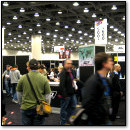No More Blinkies: Replacing the NES’s 72-Pin Cartridge Connector
Monday, November 7th, 2005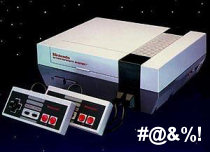 It’s an endless struggle; an epic, no-holds-barred wrestling match: Man vs. NES in a fight to the death. Or at least, in a fight to get your NES games working on that old front-loading NES. You push, it blinks. You pull, it blinks. You blow, you sneeze, you use q-tips, cleaning kits, and wow…it works? You see the title screen, but it’s still a little flaky. Things might be a little garbled, so you hit reset and it looks OK. Then an hour into playing, you accidentally tap the console and the game freezes, forcing you to start your Metroid game all over again. Blast! It’s hard to remember that your NES ever worked on the first try. There’s a fine art to actually getting a game running on an old NES. It takes a lot of patience and a certain flick of the wrist. I used to impress people at parties with my NES-charming abilities, and boy did the ladies love it.
It’s an endless struggle; an epic, no-holds-barred wrestling match: Man vs. NES in a fight to the death. Or at least, in a fight to get your NES games working on that old front-loading NES. You push, it blinks. You pull, it blinks. You blow, you sneeze, you use q-tips, cleaning kits, and wow…it works? You see the title screen, but it’s still a little flaky. Things might be a little garbled, so you hit reset and it looks OK. Then an hour into playing, you accidentally tap the console and the game freezes, forcing you to start your Metroid game all over again. Blast! It’s hard to remember that your NES ever worked on the first try. There’s a fine art to actually getting a game running on an old NES. It takes a lot of patience and a certain flick of the wrist. I used to impress people at parties with my NES-charming abilities, and boy did the ladies love it.
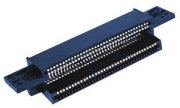 The crux of this classical problem is a special connector inside the unit that wears out from repeated usage over the years. It was designed in such a way that a game cartridge can be inserted at a slight angle with little resistance, then pushed down in the spring-and-latch loading tray inside the NES, bringing the cartridge’s contacts in full contact with the connector’s pins. It’s sort of like a cartridge port version of a ZIF (zero insertion force) socket (Hmm.. Zero Insertion Force sounds like it would have been a good title for a Japanese NES game). This mechanism seems like a great idea on paper — there’s no brute-forcing the game in, and it’s easy to pull the game out of the slot when you’re done. But this delicate dance between cartridge and machine repeats it self over and over again throughout the years until the the pins in the internal connector start to lose their flexibility and springiness. And when they get slowly bent down from repeated usage, the physical contact made between the connector and the cartridge itself suffers, making it hard for the NES to read the data on the cartridge. On top of that, you have years of dust, dirt, and corrosive build-up on both the internal connector and the game itself. As a result, you get…Dum Dum Dum…The Blinkies.
The crux of this classical problem is a special connector inside the unit that wears out from repeated usage over the years. It was designed in such a way that a game cartridge can be inserted at a slight angle with little resistance, then pushed down in the spring-and-latch loading tray inside the NES, bringing the cartridge’s contacts in full contact with the connector’s pins. It’s sort of like a cartridge port version of a ZIF (zero insertion force) socket (Hmm.. Zero Insertion Force sounds like it would have been a good title for a Japanese NES game). This mechanism seems like a great idea on paper — there’s no brute-forcing the game in, and it’s easy to pull the game out of the slot when you’re done. But this delicate dance between cartridge and machine repeats it self over and over again throughout the years until the the pins in the internal connector start to lose their flexibility and springiness. And when they get slowly bent down from repeated usage, the physical contact made between the connector and the cartridge itself suffers, making it hard for the NES to read the data on the cartridge. On top of that, you have years of dust, dirt, and corrosive build-up on both the internal connector and the game itself. As a result, you get…Dum Dum Dum…The Blinkies.
Back in the day, we just threw up our hands and suffered with the problem, never really thinking there could be a solution — other than buying a later model top-loading NES (released in 1993), which eschewed the high-class ZIF mechanism for a more plebeian (and low cost) approach. And as we all now know, recent attempts at NES replacements just don’t cut it. But a few years ago, enterprising young lads on Ebay started selling replacement 72-pin connectors (the cartridge port on the NES has 72 pins) for afflicted front-loading NES systems. The concept is this: you buy a new connector, you disassemble your NES and replace the old one, and supposedly the blinkies will be gone. So about three months ago, I finally decided to buy one and try it out. Sellers want anywhere from $7 to $12 (!) a piece for these things, which is a lot of markup considering they’re probably being churned out by Chinese factories at a cost of a cent a piece. However, they are quite unique in the world of connectors and I (in my limited experience) know of no other device that has ever used such a component. So until we find out who these sellers are smuggling these things from, the gaming public will have to put up with the high prices.
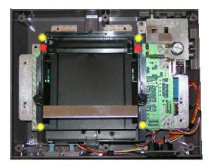 I took a dive and went with a $7 connector from HitGaming.com. I bought it through Ebay, although HitGaming has its own online store too. The choice of a vendor for these things probably matters very little. I highly suspect that all of them come from the same manufacturer somewhere in the Far East. Just go for the cheapest price. HitGaming.com’s 72-pin connector arrived in a little plastic baggy with a cheaply done single-sheet print out of NES disassembly and connector installation instructions. Having disassembled a number of NESes before, I didn’t have any trouble with the installation — it’s very easy as far as console fixes go. But for those who are not experienced in taking anything apart, the operation might be a tad tricky. HitGaming.com also has extended installation instructions online with more pictures, which is definitely handy for the inexperienced. I’m not going to go into detail about the assembly and installation instructions myself, since the method to do so has been repeated many times over on the web.
I took a dive and went with a $7 connector from HitGaming.com. I bought it through Ebay, although HitGaming has its own online store too. The choice of a vendor for these things probably matters very little. I highly suspect that all of them come from the same manufacturer somewhere in the Far East. Just go for the cheapest price. HitGaming.com’s 72-pin connector arrived in a little plastic baggy with a cheaply done single-sheet print out of NES disassembly and connector installation instructions. Having disassembled a number of NESes before, I didn’t have any trouble with the installation — it’s very easy as far as console fixes go. But for those who are not experienced in taking anything apart, the operation might be a tad tricky. HitGaming.com also has extended installation instructions online with more pictures, which is definitely handy for the inexperienced. I’m not going to go into detail about the assembly and installation instructions myself, since the method to do so has been repeated many times over on the web.
I took everything apart — first the main chassis, then the RF shield, then they tray mechanism, then unplugged the old connector from the mainboard, hollowed out some incompletely drilled screw holes in the new connector, and plugged it in to the mainboard. Then I screwed only the tray mechanism back so I could test it before completely putting it back together. If I had to give one tip for the process, it would be this: there is a black plastic lip/slot on the bottom of the black spring-loaded tray that is designed to go under the front, bottom edge of the main board. Make sure you slide the tray mechanism in parallel to the mainboard and that the lip goes under the board, or else the tray will stick up too much and the spring-locking mechanism won’t work properly. After successful testing, reassemble everything else in reverse order, taking care not to mix up which screws go where.
The new 72-pin connector in my NES succeeded in eliminating the confounded blinkies. It should be heavily noted that your game cartridges need to be cleaned before inserting them into your newly refurbished NES, or else you’ll still have trouble getting them to work (and you’ll get your new connector dirty).
There was only one problem with my connector, though. The whole ingeniously-designed ZIF feature of the tray-loader was somehow negated by the new connector. It requires a strong force to push the cartridge in, and a Herculean effort to remove the cart from the system. The sheer gripping power of the new connector will surely lessen over time and use, but it’s definitely inconvenient to have to struggle to pull a game out. It’s a disappointment, but at least a cleaned cartridge works on the first try. Also, you can practically throw the NES across the room and not have the game lock up on you; the contact is that strong. Still, I wouldn’t try it on purpose (although it might happen spontaneously while trying to get past the first stage of Ghosts ‘N Goblins).
Note: Below, I am reviewing my particular connector, not the whole concept of replacing your old one.
| HitGaming.com Replacement NES 72-Pin Connector | |
| Good Features: | Seemingly good quality construction, same dimensions as old connector. Eradicates the blinkies if installed correctly and used with clean carts. Installation instructions provided on paper and online. |
| Bad Features: | Overpriced. Skimpy installation instructions. Grabs on to your carts for dear life and won’t let go. Requires disassembly and possible breakage risk in the process — not a good option for the technically unexperienced. |
| VC Rating: (10 Being Best) |
[ 6 out of 10 ] Shiny Marbles |
 Yeah, I know, this joystick is old news. It’s probably been reviewed dozens of times. But when it first came out, I didn’t have a Vintage Computing and Gaming blog. So now I get to play catch-up and review all kinds of nifty things I’ve been buying and collecting over the years, just to add another voice to the chorus of public opinion, and to help my fellow enthusiasts, of course. And in this case, I specifically wanted to review the
Yeah, I know, this joystick is old news. It’s probably been reviewed dozens of times. But when it first came out, I didn’t have a Vintage Computing and Gaming blog. So now I get to play catch-up and review all kinds of nifty things I’ve been buying and collecting over the years, just to add another voice to the chorus of public opinion, and to help my fellow enthusiasts, of course. And in this case, I specifically wanted to review the 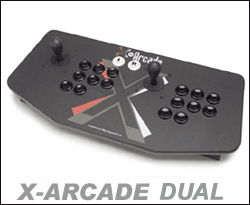 I bought my X-Arcade Dual over three years ago, and it has held up very well over the years. I originally used it with a PS/2 to USB adapter on my iMac to play arcade games in MAME. Then for a while I had a dedicated (if pathetic) MAME PC that I used the Dual with to play emulated arcade games, of course. I originally decided to get the Dual model so my buddy and I could play two-player games together (loads of fun and works great), but the extra joystick also comes in handy for games like Robotron: 2084 and Smash TV that use two joysticks in their original cabinets (one for movement and one to fire in a certain direction).
I bought my X-Arcade Dual over three years ago, and it has held up very well over the years. I originally used it with a PS/2 to USB adapter on my iMac to play arcade games in MAME. Then for a while I had a dedicated (if pathetic) MAME PC that I used the Dual with to play emulated arcade games, of course. I originally decided to get the Dual model so my buddy and I could play two-player games together (loads of fun and works great), but the extra joystick also comes in handy for games like Robotron: 2084 and Smash TV that use two joysticks in their original cabinets (one for movement and one to fire in a certain direction).
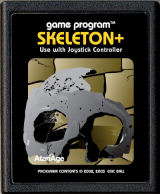 First of all, the store’s design and functionality is excellent. It is organized in a relatively easy to understand and navigate manner. If I ever ran an online store, I’d probably shamelessly pattern it after AtariAge’s store/shopping cart software (whether custom or a modified package, it’s still good). AtariAge’s checkout process integrates seamlessly into the PayPal system and payment via credit card is easy and fast (AtariAge also accepts check/money order payment, but I haven’t tried that). Their shipping options (typically USPS First Class and USPS Priority Mail) are realistic and actual-cost — no shady handling fees padded onto the total. After waiting a week or maybe less, depending on which shipping method selected, your package arrives. I personally was very happy with the speed at which the products got here, and the professionalism with which they were packed (the padding seemed adequate for the items inside), complete with a packing slip / receipt inside the box. The items that I ordered were exactly as described, obviously handled with care and in excellent condition.
First of all, the store’s design and functionality is excellent. It is organized in a relatively easy to understand and navigate manner. If I ever ran an online store, I’d probably shamelessly pattern it after AtariAge’s store/shopping cart software (whether custom or a modified package, it’s still good). AtariAge’s checkout process integrates seamlessly into the PayPal system and payment via credit card is easy and fast (AtariAge also accepts check/money order payment, but I haven’t tried that). Their shipping options (typically USPS First Class and USPS Priority Mail) are realistic and actual-cost — no shady handling fees padded onto the total. After waiting a week or maybe less, depending on which shipping method selected, your package arrives. I personally was very happy with the speed at which the products got here, and the professionalism with which they were packed (the padding seemed adequate for the items inside), complete with a packing slip / receipt inside the box. The items that I ordered were exactly as described, obviously handled with care and in excellent condition.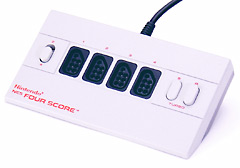 Over the past 6 years I have been looking for an easy way to interface my original NES pad with my PC so I could play NES games on an emulator with an authentic feel. There was only one realistic option I knew of: a parallel port interface hack that had spread around the Net over the years, but I never quite got around to doing it. Then, early this year I stumbled across
Over the past 6 years I have been looking for an easy way to interface my original NES pad with my PC so I could play NES games on an emulator with an authentic feel. There was only one realistic option I knew of: a parallel port interface hack that had spread around the Net over the years, but I never quite got around to doing it. Then, early this year I stumbled across 
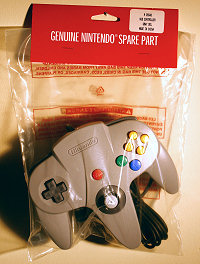 Last week I ordered two new
Last week I ordered two new 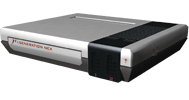 I received my
I received my 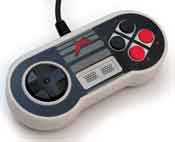 The compatibility problem brings me to another issue. I suspect that the Messiah guys didn’t do the hardware development on this machine. I think they probably repackaged the latest Asian gray-market Famicom clone, perhaps adding the built-in wireless controller functionality themselves in the process (supposedly its best selling point, although I have not tested it). If anyone can find some hardware design credits on their site (There are none in the system manual, only to the “President” and some marketing guys), let us all know. This whole thing stinks like fish. And speaking of the President, here’s an inspiring word from the man himself, direct from their May 23rd, 2005 press release:
The compatibility problem brings me to another issue. I suspect that the Messiah guys didn’t do the hardware development on this machine. I think they probably repackaged the latest Asian gray-market Famicom clone, perhaps adding the built-in wireless controller functionality themselves in the process (supposedly its best selling point, although I have not tested it). If anyone can find some hardware design credits on their site (There are none in the system manual, only to the “President” and some marketing guys), let us all know. This whole thing stinks like fish. And speaking of the President, here’s an inspiring word from the man himself, direct from their May 23rd, 2005 press release:


